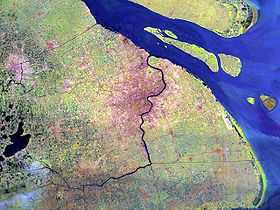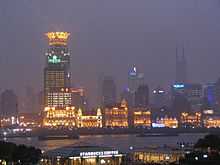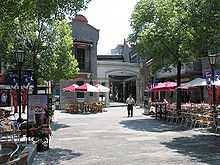Geography of Shanghai
| Geography of Shanghai | |
 | |
| Continent | Asia |
| Location | Yangtze River Delta |
| Coordinates | 31°12′N 121°30′E / 31.200°N 121.500°E |
| Area | Total: 6,340 km2 (2,450 sq mi) - Land: 6,218 km2 (2,401 sq mi) - Water: 121 km2 (47 sq mi) |
| Average elevation | 4 m (13 ft) above sea level |
The geography of Shanghai is characterised by its location on the Yangtze River Delta on China's east coast and its proximity to the Pacific Ocean via the East China Sea. The city is centred around the Huangpu River, a tributary of the Yangtze River, and extends outwards in all directions, with the suburbs and satellite towns reaching east to the East China Sea, north and west to Jiangsu province, and south to Zhejiang province over Hangzhou Bay.
The vast majority of Shanghai's land area is flat, apart from a few hills in the southwest corner, due to its location on the alluvial plain of the Yangtze's river delta. The city has many rivers and lakes and is known for its rich water resources, and thanks to its coastal, riverside location and warm climate ensuring ice-free waters, provides easy access to China's interior, resulting in Shanghai being the world's largest port.[1]
Statistics
Location
Shanghai is located in the middle of China's east coast, near the mouth of the Yangtze River, being one of the core cities in the Yangtze River Delta region. It is bordered by the Yangtze River to the north, the East China Sea to the east, Hangzhou Bay to the south, and Jiangsu and Zhejiang Provinces to the west. The city is roughly equidistant to Beijing and Hong Kong, and is located at 31°12′N 121°30′E / 31.200°N 121.500°E, roughly the same latitude as San Diego, New Orleans, Bermuda, Marrakech, Cairo, Jerusalem, and Lahore. Cities within mainland China that lie on approximately the same longitude include Fuxin, Jinzhou, Dalian, Yantai, Ningbo, and Taizhou (Zhejiang). The municipality lies about due north of Taipei and Manila.
- Latitude: 30° 42' to 31° 52' N
- Longitude: 120° 52' to 121° 58' E
Area
- Municipality:[2]
- Total: 6,340.5 km2 (2,448.1 sq mi)
- Land: 6,218.65 km2 (2,401.03 sq mi)
- Water: 121.85 km2 (47.05 sq mi)
Waterways
Shanghai contains 53.1 km (33.0 mi) of rivers and streams and is part of the Lake Taihu drainage area. Suzhou Creek is 125 km (78 mi) long and has an average width of 70 to 80 meters, while the Huangpu River is 80 km (50 mi) long and is around 400 meters wide.[2]
Islands
There are three larger low-altitude alluvial islands in the mouth of Yangtze. Chongming Island in the middle of the Yangtze is an alluvial island formed by silt carried along the river. It gives the name to the Chongming County, the only county of Shanghai. It is the third largest island in China at 1,041.21 km2 (402.01 sq mi). The other two are Changxing Island at 88.54 km2 (34.19 sq mi), and Hengsha Island at 55.74 km2 (21.52 sq mi).[2]
Shanghai has also number of smaller islands under its jurisdiction.
The Jiuduansha Island (31º03'N~-31º17'N; 121º46'E-122º15'E, area: 423.2 km2 above -6 m, 114.6 km2 at the elevation of the sea level) has the national nature reserve, Jiuduansha Wetland. 's%20Site-Jiuduansha%20Island-1.pdf
Dajinshan Island (Big Jinshan Island), Xiaojinshan Island (Small Jinshan Island), and Fushan Island in Jinshan District. are nature reserves under city jurisdiction.
Some alluvial islands are relatively young. For example, Jiuduansha emerged in 1950s. In 2006, the city had 19 uninhabited islands covering 226.27 square kilometers, with a total coastline length of 309 kilometers. Dajinshan has the highest point of Shanghai with altitude of 103.4 m.
Climate
| Shanghai | ||||||||||||||||||||||||||||||||||||||||||||||||||||||||||||
|---|---|---|---|---|---|---|---|---|---|---|---|---|---|---|---|---|---|---|---|---|---|---|---|---|---|---|---|---|---|---|---|---|---|---|---|---|---|---|---|---|---|---|---|---|---|---|---|---|---|---|---|---|---|---|---|---|---|---|---|---|
| Climate chart (explanation) | ||||||||||||||||||||||||||||||||||||||||||||||||||||||||||||
| ||||||||||||||||||||||||||||||||||||||||||||||||||||||||||||
| ||||||||||||||||||||||||||||||||||||||||||||||||||||||||||||


Shanghai has a humid subtropical climate (Köppen climate classification Cfa) and experiences four distinct seasons. In winter, cold northerly winds from Siberia can cause nighttime temperatures to drop below freezing, and although not usually associated with snow, the city can receive one or two days of snowfall per year. In contrast, and in spite of being the peak tourist season, summer in Shanghai is very warm and humid, with occasional downpours or freak thunderstorms. The city is also susceptible to typhoons, none of which in recent years has caused considerable damage.[3] The most pleasant seasons are Spring, although changeable, and Autumn, which is generally sunny and dry.
Climate statistics of 2006:[2]
- Average annual temperature: 18.4 °C (65.1 °F)
- Highest recorded air temperature: 38.6 °C (101.5 °F)
- Lowest recorded air temperature: −3.5 °C (25.7 °F)
- Annual hours of sunshine: 1,638.2
- Annual days of sunshine: 73
- Evaporation: 862.1 mm (33.9 in)
- Precipitation: 1,042.6 mm (41.0 in)
- Annual rainy days: 129
- Frost-free period: 333 days
| Climate data for Shanghai (1971–2000) | |||||||||||||
|---|---|---|---|---|---|---|---|---|---|---|---|---|---|
| Month | Jan | Feb | Mar | Apr | May | Jun | Jul | Aug | Sep | Oct | Nov | Dec | Year |
| Average high °C (°F) | 8.1 (46.6) |
9.2 (48.6) |
12.8 (55) |
19.1 (66.4) |
24.1 (75.4) |
27.6 (81.7) |
31.8 (89.2) |
31.3 (88.3) |
27.2 (81) |
22.6 (72.7) |
17.0 (62.6) |
11.1 (52) |
20.2 (68.3) |
| Average low °C (°F) | 1.1 (34) |
2.2 (36) |
5.6 (42.1) |
10.9 (51.6) |
16.1 (61) |
20.8 (69.4) |
25.0 (77) |
24.9 (76.8) |
20.6 (69.1) |
15.1 (59.2) |
9.0 (48.2) |
3.0 (37.4) |
12.9 (55.1) |
| Precipitation mm (inches) | 50.6 (1.992) |
56.8 (2.236) |
98.8 (3.89) |
89.3 (3.516) |
102.3 (4.028) |
169.6 (6.677) |
156.3 (6.154) |
157.9 (6.217) |
137.3 (5.406) |
62.5 (2.461) |
46.2 (1.819) |
37.1 (1.461) |
1,164.7 (45.857) |
| Avg. precipitation days (≥ 0.1 mm) | 9.7 | 10.3 | 13.9 | 12.7 | 12.1 | 14.4 | 12.0 | 11.3 | 11.0 | 8.1 | 7.0 | 6.5 | 129.0 |
| % humidity | 75 | 74 | 76 | 76 | 76 | 82 | 82 | 81 | 78 | 75 | 74 | 73 | 76.8 |
| Mean monthly sunshine hours | 123.0 | 115.7 | 126.0 | 156.1 | 173.5 | 147.6 | 217.8 | 220.8 | 158.9 | 160.8 | 146.6 | 147.7 | 1,894.5 |
| Percent possible sunshine | 39 | 37 | 34 | 40 | 41 | 35 | 50 | 54 | 43 | 45 | 46 | 47 | 42.6 |
| Source: China Meteorological Administration [4] | |||||||||||||
Cityscape

Shanghai city proper is bisected by the Huangpu River: Puxi, on the west side, is the historic centre of the city, and includes the districts of Yangpu, Hongkou, Zhabei, Putuo, Changning, Xuhui, Jing'an, Luwan and Huangpu. Pudong is located on the east side and is the location of Shanghai's rapid development, including its new famous skyline and the Lujiazui financial district.
The outer districts, or suburbs, surround the city proper, and are Baoshan, Minhang, Jiading, Jinshan, Songjiang, Qingpu, Nanhui, Fengxian, and the rural eastern part of Pudong.
Shanghai's only county - Chongming - is in the far north of the municipality and makes up the islands of Chongming, Changxing and Hengxia.
Environment

Public awareness of the environment is growing, and the city is investing in a number of environmental protection projects. A 10-year, US$1 billion cleanup of Suzhou Creek, which runs through the city center, is expected to be finished in 2008,[5] and the government also provides incentives for transportation companies to invest in LPG buses and taxis. Air pollution in Shanghai is low compared to other Chinese cities such as Beijing, but the rapid development over the past decades means it is still high on worldwide standards, comparable to Los Angeles.[6]
Maps and satellite images
-

German map of Shanghai in 1888
-

US Army 1933 map
-

False-colour satellite image
See also
References
- ↑ "Shanghai now the world's largest cargo port". Asia Times Online. 2006-01-07. Retrieved 2008-03-16.
- ↑ 2.0 2.1 2.2 2.3 Shanghai Statistical Bureau Yearbook 2007
- ↑ Spencer, Richard (2007-09-19). "1.6m flee Shanghai typhoon". London: The Daily Telegraph. Retrieved 2008-03-20.
- ↑ "中国地面国际交换站气候标准值月值数据集(1971-2000年)" (in Simplified Chinese). China Meteorological Administration. Retrieved 2010-11-10.
- ↑ "Suzhou Creek clean-up on track". People's Daily Online. 2006-12-07. Retrieved 2008-05-11.
- ↑ "Environmental Protection in China's Wealthiest City". The American Embassy in China. July 2001. Retrieved 2008-05-11.
External links
| |||||||||||||||||||||||||||||||||||||||||||||||||||||||